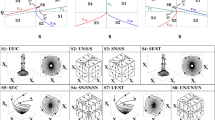Abstract
In order to determine the mean rate of product creation within the framework of the Turbulent Flame Closure (TFC) model of premixed combustion, the model is combined with a simple closure of turbulent scalar flux developed recently by the present authors based on the flamelet concept of turbulent burning. The model combination is assessed by numerically simulating statistically planar, one-dimensional, developing premixed flames that propagate in frozen turbulence. The mean rate of product creation yielded by the combined model decreases too slowly at the trailing edges of the studied flames, with the effect being more pronounced at longer flame-development times and larger ratios of rms turbulent velocity u′ to laminar flame speed S L . To resolve the problem, the above closure of turbulent scalar flux is modified and the combination of the modified closure and TFC model yields reasonable behaviour of the studied rate. In particular, simulations indicate an increase in the mean combustion progress variable associated with the maximum rate by u′/S L , in line with available DNS data. Finally, the modified closure of turbulent scalar flux is validated by computing conditioned velocities and turbulent scalar fluxes in six impinging-jet flames. The use of the TFC model for simulating such flames is advocated.
Similar content being viewed by others
References
Poinsot, T., Veynante, D.: Theoretical and Numerical Combustion, 2nd edn. Edwards, Philadelphia (2005)
Lipatnikov, A.N.: Fundamentals of Premixed Turbulent Combustion. CRC Press (2012)
Prudnikov, A.G.: Burning of homogeneous fuel-air mixtures in a turbulent flow. In: Raushenbakh, B.V. (ed.) Physical Principles of the Working Process in Combustion Chambers of Jet Engines, pp. 244–336. Clearing House for Federal Scientific & Technical Information, Springfield (1967)
Zimont, V.L.: Theory of turbulent combustion of a homogeneous fuel mixture at high Reynolds number. Combust. Explos. Shock Waves 15, 305–311 (1979)
Zimont, V.L., Lipatnikov, A.N.: A numerical model of premixed turbulent combustion. Chem. Phys. Rep. 14, 993–1025 (1995)
Lipatnikov, A.N., Chomiak, J.: Turbulent flame speed and thickness: phenomenology, evaluation, and application in multi-dimensional simulations. Prog. Energy Combust. Sci. 28, 1–74 (2002)
Bray, K.N.C, Moss, J.B.: A unified statistical model for the premixed turbulent flame. Acta Astronaut. 4, 291–319 (1977)
Lipatnikov, A.N., Chomiak, J.: Effects of premixed flames on turbulence and turbulent scalar transport. Prog. Energy Combust. Sci. 36, 1–102 (2010)
Zimont, V.L., Biagioli, F.: Gradient, counter-gradient transport and their transition in turbulent premixed flames. Combust. Theory Model. 6, 79–101 (2002)
Biagioli, F. and Zimont, V.L.: Gasdynamics modelling of counter-gradient transport in open and impinging turbulent premixed flames. Proc. Combust. Inst. 29, 2087–2095 (2002)
Sabelnikov, V.A., Lipatnikov, A.N.: A simple model for evaluating conditioned velocities in premixed turbulent flames. Combust. Sci. Technol. 183, 588–613 (2011)
Cho, P., Law, C.K., Cheng, R.K., Shepherd, I.G.: Velocity and scalar fields of turbulent premixed flames in stagnation flow. Proc. Combust. Inst. 22, 739–745 (1988)
Cheng, R.K., Shepherd, I.G.: The influence of burner geometry on premixed turbulent flame propagation. Combust. Flame 85, 7–26 (1991)
Li, S.C., Libby, P.A., Williams, F.A.: Experimental investigation of a premixed flame in an impinging turbulent stream. Proc. Combust. Inst. 25, 1207–1214 (1994)
Stevens, E.J., Bray, K.N.C., Lecordier, B.: Velocity and scalar statistics for premixed turbulent stagnation flames using PIV. Proc. Combust. Inst. 27, 949–955 (1998)
Libby, P.A., Bray, K.N.C.: Countergradient diffusion in premixed turbulent flames. AIAA J. 19, 205–213 (1981)
Lipatnikov, A.N., Chomiak, J.: Self-similarly developing, premixed, turbulent flames: a theoretical study. Phys. Fluids 17, 065105 (2005)
Libby, P.A.: Theory of normal premixed turbulent flames revisited. Prog. Energy Combust. Sci. 11, 83–96 (1985)
Im, Y.H., Huh, K.Y., Nishiki, S., Hasegawa, T.: Zone conditional assessment of flame-generated turbulence with DNS database of a turbulent premixed flame. Combust. Flame 137, 478–488 (2004)
Chakraborty, N., Lipatnikov, A.N.: Statistics of conditional fluid velocity in the corrugated flamelets regime of turbulent premixed combustion: a direct numerical simulation study. J. Combust. 628208 (2011)
Taylor, G.I.: Statistical theory of turbulence. IV. Diffusion in a turbulent air stream. Proc. R. Soc. London A 151, 465–478 (1935)
Veynante, D., Poinsot, T.: Effects of pressure gradients on turbulent premixed flames. J. Fluid Mech. 353, 83–114 (1997)
Lipatnikov, A.N.: Scalar transport in self-similar, developing, premixed, turbulent flames. Combust. Sci. Technol. 179, 91–115 (2007)
Hult, J., Gashi, S., Chakraborty, N., Klein, M., Jenkins, K.W., Cant, R.S., Kaminski, C.F.: Measurement of flame surface density for turbulent premixed flames using PLIF and DNS. Proc. Combust. Inst. 31, 1319–1326 (2007)
Chakraborty, N., Rogerson, J.W., Swaminathan, N.: A priori assessment of closures for scalar dissipation rate transport in turbulent premixed flames using direct numerical simulation. Phys. Fluids 20, 045106 (2008)
Han, I., Huh, K.Y.: Effects of the Karlovitz number on the evolution of the flame surface density in turbulent premixed flames. Proc. Combust. Inst. 32, 1419–1425 (2009)
Lee, E., Huh, K.Y.: Statistically steady incompressible DNS to validate a new correlation for turbulent burning velocity in turbulent premixed combustion. Flow Turbul. Combust. 84, 339–356 (2010)
Swaminathan, N., Grout, R.W.: Interaction of turbulence and scalar fields in premixed flames. Phys. Fluids 18, 045102 (2006)
Trouvé, A., Poinsot, T.: Evolution equation for flame surface density in turbulent premixed combustion. J. Fluid Mech. 278, 1–31 (1994)
Bray, K.N.C., Champion, M., Libby, P.A.: Premixed flames in stagnating turbulence part V—evaluation of models for the chemical source term. Combust. Flame 127, 2023–2040 (2001)
Lipatnikov, A.N.: Comments on the paper “Premixed Flames in Stagnating Turbulence Part V—Evaluation of Models for the Chemical Source Term” by Bray, K.N.C., Champion, M., and Libby, P.A. Combust. Flame 131, 219–221 (2002)
Lipatnikov, A.N.: A test of conditioned balance equation approach. Proc. Combust. Inst. 33, 1497–1504 (2011)
Author information
Authors and Affiliations
Corresponding author
Rights and permissions
About this article
Cite this article
Sabelnikov, V.A., Lipatnikov, A.N. Towards an Extension of TFC Model of Premixed Turbulent Combustion. Flow Turbulence Combust 90, 387–400 (2013). https://doi.org/10.1007/s10494-012-9409-9
Received:
Accepted:
Published:
Issue Date:
DOI: https://doi.org/10.1007/s10494-012-9409-9




